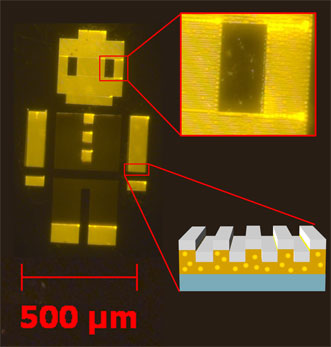Combining quantum dot (QD) and photonic crystal technology could lead to brighter and more efficient displays and lighting.
Researchers from the University of Illinois have developed a new method that extracts polarized light from QDs over a large area by embedding them in novel polymer materials that retain strong quantum efficiency. Then electrohydrodynamic jet printing was used to precisely print the QD-embedded polymers onto photonic crystal structures.

"Robot Man" was created to demonstrate the light-emitting potential of photonic-crystal-enhanced quantum dots. Courtesy of Gloria See/University of Illinois at Urbana-Champaign.
The method is less wasteful of expensive-to-make QDs than other techniques such as drop casting or spin coating. It also enables an eight-fold enhancement of light output compared with typical QDs.
"If you start with polarized light, then you double your optical efficiency," said graduate student Gloria See. "If you put the photonic-crystal-enhanced quantum dot into a device like a phone or computer, then the battery will last much longer because the display would only draw half as much power as conventional displays."
To demonstrate the technology, See fabricated a novel, 1-mm light emitter in the shape of a man. The device contains thousands of yellow photonic-crystal-enhanced QDs, each measuring about 6 nm.
"We made a tiny device, but the process can easily be scaled up to large flexible plastic sheets," See said. "We make one expensive 'master' molding template that must be designed very precisely but we can use the template to produce thousands of replicas very quickly and cheaply."
Funding came from Dow Chemical Co. The research was published in Applied Physics Letters (doi: 10.1063/1.4927648 [open access]).
For more information, visit http://engineering.illinois.edu.